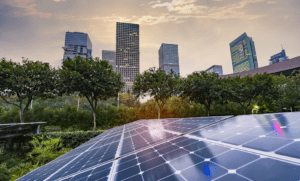The growth of power-consuming data centers has sparked interest in sustainable data centers.
- Large amounts of data increase the size of the data center, which consumes more power to manage it.
- As a result, more and more companies are looking into sustainable data center solutions and responding to climate change.
As a result of the Fourth Industrial Revolution with big data, AI, and cloud services, billions of Internet-connected devices are pouring out huge amounts of data. As such, the demand for data centers is increasing to manage and store the vast amounts of data produced every day. The pandemic last year, which could not have been predicted by anyone, resulted in unprecedented non-face-to-face working and education environments, such as telecommuting and distance learning, which in turn accelerated the digital transformation and brought about explosive growth in the data industry. As a result, there is a greater need for hyperscale data centers beyond just general data centers to handle this exponential growth of data.
Hyperscale data centers manage high-density data with high-level performance and throughput over 100,000 servers. Recently, the construction of hyperscale data centers has spread around the world due to the surge in cloud services that require large-scale servers and storage. According to the Cisco Global Cloud Index, the number of hyperscale data centers worldwide will nearly double this year compared to 2016, and the proportion of hyperscale data center servers in all data center servers will exceed 50%.
South Korea currently ranks fifth among global data producers, demonstrating a high level of data production with many Internet users and ease of data access. According to data released by the Korea Data Center Market (KDCC), the number of data centers in South Korea has grown at a rate of 5.9% per year from 53 in 2000 to 158 in 2020. During that same period, a total of 43 commercial data centers were built and operated, increasing at an average annual rate of 7.4%, and 12 additional facilities or more are expected to be completed by 2023.
Large domestic telecommunications companies are also actively engaged in the investment and expansion of construction of hyperscale IDCs (Internet Data Centers). IDC operating companies are striving to improve energy efficiency and reduce environmental pollution. This is because technologies to establish sustainable IDCs, while bolstering “environmental, social and governance (ESG) management” for corporate survival and social sustainability, are emerging with different levels of competitiveness. And accordingly, many domestic companies are announcing plans to build hyperscale data centers.
The data center industry is gradually expanding in size to manage the rapidly increasing demand for data due to the fourth industrial revolution but is also facing the problem of increased management costs and power consumption. Since data centers need to manage and operate a large amount of data stably 24 hours a day, a vast amount of power is inevitably consumed.
Furthermore, many data centers operate at temperatures between 18°C to 27°C as recommended by the American Society of Heating Refrigerating and Air-Conditioning Engineers (ASHRAE) to prevent the overheating of assets, and in order to maintain a consistently low temperature, much energy needs to be consumed, resulting in lower energy efficiency and higher operating costs
Domestic companies are also making efforts such as applying carbon-negative policies to data centers in accordance with this trend. As a result, the sustainable solution market is expected to grow in proportion to the growth of the data center industry. This is because interest in decarbonization and energy efficiency is increasing in response to climate change, and companies are also seeking specific ways to fulfill social responsibilities.
Schneider Electric possesses the solutions necessary for the establishment of sustainable data centers, such as high-level integrated architecture, intelligent power management, and building automatic control solutions and AI-based data center DCIM solutions. It’s playing a key role in helping enterprises build these data centers of the future.
There are concerns for the environment as data centers grow in size, but if companies adopt sustainable solutions, they can reduce costs by increasing energy efficiency. And by practicing carbon neutrality, they can be reborn as a company that not only protects the environment but also gain customers’ trust.
For more information, please visit my column.



